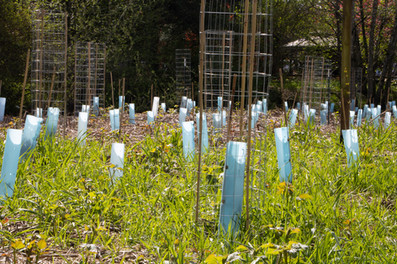Conservation Stories: Shawne and John Lidstrom
- aguddal
- 1 day ago
- 4 min read

Sometimes it is possible to stumble across a place and know it is where you are meant to be. That is how Shawne and John Lidstrom felt when they found their retirement home in Lynden. “We were walking the dogs to the park and came by to see the property. We fell in love with it. We contacted the realtor. From there everything moved very quickly and here we are.” The property was everything they didn’t know they had been looking for.
“What’s special is being next to the creek, the beautiful park and the grounds of the property – fruit trees, blueberries and raspberries, all the green grass. We love watching the ducks and other birds.” – Shawne and John Lidstrom

After moving in and taking care of some immediate needs for the home and grounds, the Lidstroms wanted to get to know the area better. They stopped by the Lynden Chamber of Commerce and saw a flyer about protecting salmon habitat. Wondering if salmon lived in their creek, they reached out to Tristan Simons, a stream habitat restoration specialist at the Whatcom Conservation District (Whatcom CD). During an onsite meeting they discovered that their creek was not only a home to salmon, but also that the mass of blackberries along their property were detrimental to salmon. They decided then and there to partner with Whatcom CD to restore the habitat along their stream.
“We believe in providing a good habitat for wildlife, and the salmon are included in that. When Tristan told us that the blackberries, which were 20 feet high on most of the property outside the grass, were not native, we trusted him to make good suggestions as to the best use of the property. We had no plans to build on it. We just loved it naturally.”

Himalayan blackberries (Rubus armeniacus) are unfortunately a common invasive species along many streams and rivers. These blackberries thrive in disturbed areas where native vegetation has been removed and are difficult to eradicate once established. They are a poor substitute for the many services that trees and other native plant species provide. They destabilize stream banks, can increase flooding, reduce shade, are worse at absorbing and filtering rainwater, and are poor habitat for many native wildlife. Whatcom CD offers streamside habitat restoration that includes removing Himalayan blackberries and suppressing their regrowth until native species can outcompete them.

“The first thing that stood out to me was the property’s short distance upstream from Bender Park. The Bender Park reach of Fishtrap Creek has been a focus of habitat restoration work in recent years, and many members of the community are familiar with it due to the public trail which parallels the creek. It made too much sense to collaborate with the Lidstroms to continue those efforts on private land upstream, especially because they were so motivated and excited to be involved in enhancing their riparian habitat.” – Tristan Simons, Habitat Restoration Specialist at Whatcom CD

As the blackberries were removed and replaced with new native saplings, Shawne and John discovered even more to love about their property. The creek is now accessible in a new way, with a “beach” area, new plants coming into bloom, and a better vantage to watch the birds from their home and yard. Some highlights have included finding a duck nest, learning about new native plants, and planting their Christmas tree for the 2025 holiday season. “We look forward to seeing the cedars and firs especially grow. We understand that the property used to be more forested than it is now in days gone by. It will be nice to have the privacy back after removing all the vegetation, too.”

The Lidstroms were not looking for a new home, but their new property was perfect for them, and they also feel like they are a perfect fit for the property. They have the time and desire to maintain the classic house, fruit trees, gardens, and berries. To Shawne and John, their effort to restore the native streamside vegetation is part of doing right by their new home. If you have a stream on your property and would like to remove invasive species or create wildlife habitat, contact Whatcom CD. We have free stream restoration services that include confidential site visits, planning, planting, plants, invasive species removal, and maintenance to keep the invasive species from returning. Fill out our Site Visit Request form to contact one of our restoration specialists today.
“This has definitely been a great experience. We want to be good caretakers so we can see more fish, birds and maybe butterflies and dragonflies on the property. We saw a deer here when we first moved in, and we hope she comes back too. We would highly recommend both the Conservation District and NSEA. They have been very responsive and communicative. They have answered any questions we had and educated us on what to expect going forward.” -Shawne and John Lidstrom

















Komentarze